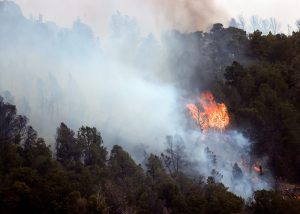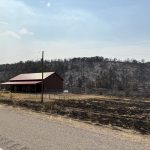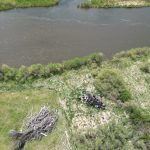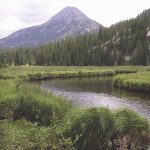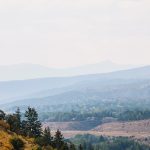Efforts to relocate an ancient wetland could help determine the fate of a water project on Lower Homestake Creek
Fens, which are groundwater-fed wetlands filled with organic 'peat,' are among the state’s most biodiverse and fragile environments
Aspen Journalism

Brent Gardner-Smith | Aspen Journalism
LAKE COUNTY — One morning last month, Brad Johnson arrived at a patch of rippling yellow grasses alongside U.S. 24, a few miles south of Leadville in the upper Arkansas River valley. Sandwiched among a cluster of abandoned ranch buildings, a string of power lines and a small pond, it is an unassuming place — except, of course, for its views of 14,000-foot peaks rising across the valley.
But appearances can be deceiving. The rather ordinary-looking property was a fen, which is a groundwater-fed wetland filled with organic “peat” soils that began forming during the last ice age and that give fens their springy feel.
“It’s like walking on a sponge,” Johnson said, marching across the marshy ground, stopping every now and then to point out a rare sedge or grass species.
Johnson was visiting the fen to record groundwater measurements before winter sets in. As the lead scientist for the Rocky Mountain Fen Research Project, Johnson is part of an effort spearheaded and paid for by Aurora Water and the Board of Water Works of Pueblo to study new ways to restore fens.
The research could help facilitate future water development in Colorado, such as the potential Whitney Reservoir project, part of a 20-year water-development plan from Aurora Water and Colorado Springs Utilities for the upper Eagle River watershed. The utilities, working together as Homestake Partners, are looking at building the reservoir in the Homestake Creek valley, south of Minturn, in an area that probably contains fens, which could hinder the project.

Support Local Journalism
Aurora and Colorado Springs are working together on the reservoir project, and Aurora and Pueblo are funding the fens research. Although the Whitney project is not directly tied to the fen project, if the research efforts are successful, they could help Aurora and Colorado Springs secure a permit approval for the reservoir — and maybe alter the fate of an ecosystem.
Irreplaceable resources
If you’ve walked through Colorado’s high country, chances are you’ve walked by a fen, which are among the state’s most biodiverse and fragile environments. To protect fens, the U.S. Fish and Wildlife Service and the Environmental Protection Agency drafted a “fen policy” in 1996. The policy, amended in 1999, determined that fens are irreplaceable resources because their soils take so long to regenerate. “On-site or in-kind replacement of peatlands is not possible,” the policy reads.
Inside the Fish and Wildlife Service, however, a different interpretation emerged. “Irreplaceable” became “unmitigable,” making it difficult or impossible to secure approval for any project that would severely impact fens.
Although Johnson is in favor of fen conservation, the Fish and Wildlife Service’s “unmitigable” interpretation bothered him. Not only was that status not supported by the fen policy itself, he believes saying “no” all the time is not in the best interest of fens.

Sarah Tory | Aspen Journalism
“My fear is that if we don’t have the means of mitigating our impacts, we’ll just impact them,” he said.
Eventually, Johnson believes, conservationists will have to make some concessions to development. But by researching better mitigation techniques, he hopes he can help preserve fens in the long run.
An organ transplant
For water utilities, fens have been particularly troublesome. Fens like to form in high-alpine valleys, the places best suited for dams and water reservoirs that take water from rivers mostly on the Western Slope and pump it over the mountains to supply the Front Range’s growing population.
But the fen policy has stymied many of the utilities’ plans to develop new water projects. Those defeats helped spur Front Range utilities to start researching new mitigation strategies that would help them comply with environmental regulations — and get around the fen policy.
“They wanted to figure out how to do this right so they could actually permit their projects,” Johnson said.
Through the fen-research project, Aurora and Pueblo saw an opportunity to address the fen policy’s requirement that a project offset unavoidable impacts to a fen by restoring an equivalent amount of fen elsewhere.

Sarah Tory | Aspen Journalism
Since the fen project began 16 years ago, Aurora and Pueblo have invested $300,000 and $64,000 in the research, respectively. More recently, other funders have joined the effort, including the Colorado Water Conservation Board ($100,000).
After a number of fits and starts, Johnson three years ago settled on a design for the research that would test whether it’s ecologically possible to transplant fen soils from one location to another. First, Johnson restored the original groundwater spring at the old Hayden Ranch property. Then, he and a team of helpers removed blocks of soil from another degraded fen site and reassembled them, like an organ transplant, at the “receiver” site, where the restored spring now flows through veinlike cobble bars and sandbars, feeding the transplanted fen.
Positive signs
It’s still too early to know whether the project could eventually serve as a fen-mitigation strategy for a new reservoir, but Johnson is optimistic about the results thus far. In 2017, after just one growing season, he was shocked to discover 67 different plant species growing at the transplanted fen site — compared with just 10 at the donor site. He was thrilled by the news. The data showed that the transplanted fen ecosystem is thriving.
That’s good news for utilities such as Aurora, too.
A week after Johnson visited the Rocky Mountain Fen Project site, Kathy Kitzmann gave a tour of the wetland-filled valley formed by Homestake Creek where Aurora and Colorado Springs are planning to build Whitney Reservoir.
Kitzmann, a water resources principal for Aurora Water, drove down the bumpy, snow-covered road that winds along the valley bottom, pointing to the two creeks that would — along with Homestake Creek and the Eagle River, near Camp Hale — help fill the reservoir. A pump station would send the water upvalley to the existing Homestake Reservoir and then through another series of tunnels to the Front Range.

Sarah Tory | Aspen Journalism
In the lower part of the valley, Kitzmann stopped at the first of four potential reservoir sites — ranging in size from 6,000 acre-feet to 20,000 acre-feet — that the utilities have identified for the project and the wetlands it would inundate.
“You can sort of see why it wouldn’t be the best, just given the vastness of the wetlands,” Kitzmann said.
Farther along, the valley becomes more canyonlike, with higher rocky walls and fewer wetlands — probably offering a better reservoir site, said Kitzmann, although the permitting agencies won’t know for sure until they complete their initial feasibility studies.
In June, Aurora and Colorado Springs submitted a permit application to the U.S. Forest Service to perform exploratory drilling and other mapping and surveying work, but the agency has not yet approved the permit.
Potential fen impacts are just one of several environmental hurdles facing the project. One of the Whitney alternatives would encroach on the Holy Cross Wilderness. Aurora and Colorado Springs have proposed moving the wilderness boundary, if necessary, to accommodate the reservoir.
It’s also likely that the wetlands in the Homestake Valley contain fens, but until the utilities conduct wetland studies around the proposed reservoir sites next summer, the scope of the impacts remains uncertain.
Environmental groups including Colorado Headwaters, a nonprofit, oppose the Whitney Reservoir project, arguing that it would destroy one of the state’s most valuable wetlands, as well as an important habitat for wildlife and rare native plants.
In the meantime, Aurora is hopeful that Johnson’s research might one day help solve some of the environmental problems around new water development. “We are excited about proving that you can restore and rehabilitate fens,” Kitzmann said.
Inevitable impacts
But is a transplanted fen as good as not touching one in the first place?
A Fish and Wildlife Service spokesperson said fens are still designated a “Resource Category 1,” which means that the appropriate type of mitigation is avoidance, or “no loss.”
White River National Forest supervisor Scott Fitzwilliams echoed the spokesperson’s statement, noting that land managers place a high emphasis on protection for fens: “It’s really hard to replace a wetland in these high elevations.”
Johnson, asked whether he was worried that his research into fen mitigation might end up facilitating the kinds of projects that are most damaging to fens. He sighed. “I’m sensitive to that,” he said.
But like it or not, Johnson believes that more impacts to
fens are inevitable. As Colorado’s population grows, water utilities will have
to build new reservoirs, the state will need new roads and ski resorts will
want to expand.
“I can’t argue with whether they should get built,” he said. “I’m just a
wetlands guy.”
Editor’s note: Aspen Journalism collaborates with the Vail Daily and other Swift Communications newspapers on coverage of water and rivers. For more, go to aspenjournalism.org.

